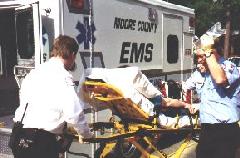|
1. First clarify the type of crisis, the intensity of the crisis and also the number of victims. Ask yourse lf whether the crisis is an emergency, crisis or urgency. lf whether the crisis is an emergency, crisis or urgency.
We look at these on a scale as though an emergency is the most serious, a crisis somewhat less serious, and an urgency is the least serious.
An emergency might be involve an unconscious or shock victim, excessive bleeding, breathing difficulties, or other situations where an immediate response is required (including death.)
A crisis might be a situation (simple or complex) that the victim perceives to be intolerably difficult. Typically, if someone thinks there is a crisis, they will act like it's a crisis. For example, the situation may be:
- where an individual's personal coping skills have been exhausted, creating personal chaos and the individual perceives that there are no viable choices
- where both danger and opportunity are present simultaneously (i.e., someone may be very ill (danger,) but can go to the hospital (opportunity).)
- a time-limited situation or what we call a transcrisis. (i.e., locking keys in one's car)

The crisis may create imbalance, disorganization and chaos or it may serve as a catalyst for new and positive changes. The important thing to remember is that the MEANING is a matter of individual perception. A crisis for one person may be ordinary work for someone else.
It's also good to know that stress can contribute to crises. Some stress is normal and can even produce creativity and energy. However, a crisis situation can result if an individual believes they have more than they can handle at once. So, if we have a crisis - what kind is it? Ask yourself, "Is it a Situational, Maturational, Existential or a Combination Crisis?"
An urgency is a situation that has the potential for becoming a crisis. However, it can ususally be resolved with immediate constructive action. (For example, an urgency might be trouble getting to work on time when traffic is bad or needing to get sacks of groceries from the car to the house when it's starting to rain.)
TYPES OF CRISIS

A Situational crisis can include rape, fire, assault, murder, theft, car accidents, divorce, loss of a job, financial problems, loss of pets, Post Traumatic Stress Disorder, locked keys in the car, panic attacks, disasters, etc.
A Maturational crisis can include stress caused by changes that occur during a person's maturational growth (things that come with age,) such as: entering preschool, high school, beginning adolescence, entering college, graduating college, getting married, having a child, mid-life experiences, retirement, etc. An individual can experience a loss of control, loss of space, or feelings of anbandonment (which can cause anger, bitterness, frustration).
An Existential crisis can involve serious value/belief conflicts, like abortion, euthanasia, religious and social issues, etc.
When we say there can be a combination, we mean that someone can experience some of these situations simultaneously. After you classify the type of crisis, you need to determine the intensity of the situation by assessing the Mobility and Lethality of the victim(s).

To determine Mobility you must determine if the victim can move after an injury. Are they in shock? Are they grieving? Determine how immobile they are at the time.
 To assess the Lethality determine how dangerous the situation is to the victims; or how dangerous the person is to others or themselves. The lethality depends on the type of encounter. For instance, in an emergency someone may be near death; in a maturational crisis, an individual might be dangerous to him/herself or to others if they are angry or depressed (i.e., threatening suicide.) During an urgency, an individual may not be lethal at all. To assess the Lethality determine how dangerous the situation is to the victims; or how dangerous the person is to others or themselves. The lethality depends on the type of encounter. For instance, in an emergency someone may be near death; in a maturational crisis, an individual might be dangerous to him/herself or to others if they are angry or depressed (i.e., threatening suicide.) During an urgency, an individual may not be lethal at all.
|
|
2. Second, check the scene and maintain a calm response.
During this step, check the scene for things like the number of victims, available help or helpers, power lines in the case of an accident, etc. It is important to maintain a calm response (modeling firefighters, police, paramedics.) This involves monitoring the activity and responding efficiently. Use these two steps to assist you:
 1. If there is an unconscious or shock victim, call 911 immediately. 1. If there is an unconscious or shock victim, call 911 immediately.
2. If there are conscious victims, prioritize the injuries as needed or develop teams if there is help.
- Get their permission to help them (Texas has the Good Samaritan Law).
- Show empathy for their problem.
- Get information from them (name, hurts, etc.).
- Ask Direct Questions
- Are you bleeding?
- Have you taken any drugs?

- Ask Open Questions
- How do you feel about this?
- How many choices do you have?
- Ask Clarifying Questions
- Is Susan your sister?
- Is this your parents' phone number?
- Who else did you tell?
- Assess their needs, and provide assurance to them.
|



